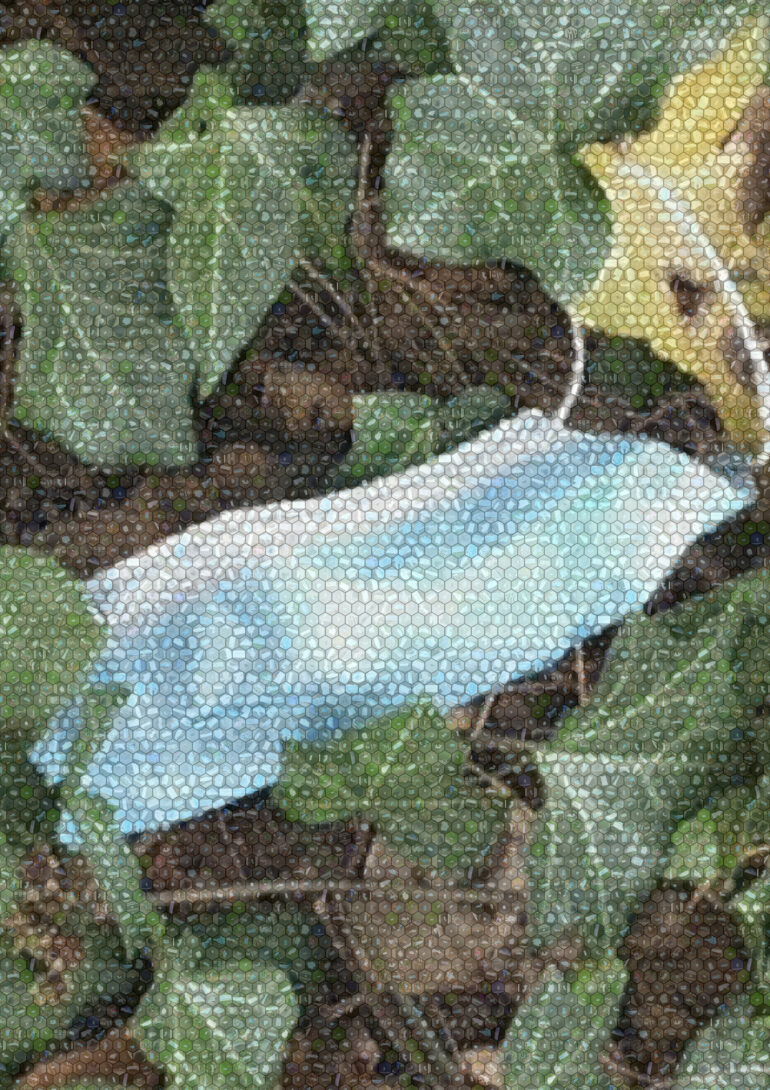A new study has found face mask litter increased by 9,000% from March to October 2020. It shows a direct link between national legislation and the occurrence of discarded waste that included face masks and other COVID-19 related personal protective equipment.
Researchers from the University of Portsmouth are urging Governments to put in place policies and legislation for the disposal of littered face masks when making the wearing of them mandatory.
The study, published today in the journal Nature Sustainability, was based on findings from two open source databases: the extensive “COVID-19 Government Response Tracker” and a litter collection app called “Litterati“.
More than two million pieces of litter were collected across 11 countries, which between them had a range of COVID-19 policy responses. Using these databases, researchers were able to map the countries policy responses (lockdown severity, mask policies), and gain a base line of litter proportions from September 2019 through the first six months of the pandemic.
Lead researcher Dr. Keiron Roberts, Lecturer in Sustainability and the Built Environment at the University of Portsmouth, said: “Overall the study shows the impact that legislating the use of items such as masks can have on their occurrence as litter. We found that littered masks had an exponential increase from March 2020, resulting in an 84-fold increase by October 2020. There is a clear need to ensure that requiring the use of these items is accompanied with education campaigns to limit their release into the environment.”
Explaining the background for the research, Dr. Roberts said: “The negative impacts of COVID-19 on our daily lives are well known. In April 2020, it was beginning to appear that there were some small positives in the decrease in human activity caused by lockdown, with improvements in air quality and water quality. Reduced human activity also saw reports of animals coming back to towns and cities. At the same time, reports of masks and gloves appearing on beaches and streets, where they hadn’t been before, started to emerge. As COVID-19 spread, so did the news reports of this new type of litter. National lockdowns made it incredibly difficult to go out and visit these places to gather evidence of what were anecdotal accounts.”
Having struggled to collect data in the field, the researchers turned to the online databases. Dr. Roberts said: “This data allowed us to look at the COVID-19 litter trends on a monthly basis. We then matched up the WHO announcements and national policy and lockdown restrictions to see how this impacted litter proportions. It wasn’t a surprise to see mask litter appear, but what did surprise us was how national legislation had dramatically impacted the occurrence of mask litter.”
The following trends emerged:
January—March. As countries grappled for adequate PPE the guidance was to socially/ physically distance from each other. March—May. The most severe lockdowns were during this period, and as such, mask littering was low but on the increase. June—October. The WHO recommended the use of masks to help facilitate social interaction. This followed the relaxation of many lockdown measures, and so an increase in people’s freedoms. Mask litter increased dramatically within these months.
Professor Steve Fletcher, Director of Revolution Plastics at the University of Portsmouth, said: “Despite millions of people being told to use face masks, little guidance was given on how to dispose of them or recycle them safely. Without better disposal practices, an environmental disaster is looming. The majority of masks are manufactured from long-lasting plastic materials, and if discarded can persist in the environment for decades to hundreds of years. This means they can have a number of impacts on the environment and people.”
Almost all litter is avoidable but often the impact only appears to be visual. There are multiple direct impacts littering has on the world around us:
Short-term Litter acts as a potential viral vector to transmit COVID-19. If they enter the sewers they can cause potential blockages where they entangle with other items such as leaves.Medium-term For large animals, they can entangle and choke them, and if eaten cause complications. Where the litter lands can smother smaller organisms and plant life.Long-term Once in the environment, littered items can continue to have the impacts mentioned above, with the addition of becoming a transmission route for other pollutants. If made from plastic, they will eventually become micro plastics and have the potential to enter the food chain.
Dr. Roberts concludes: “We need to avoid this pandemic litter becoming a lasting legacy. There are two important messages to learn from this study. Firstly, COVID-19 was a major driver in the emergence of mask litter and secondly, government policies and legislation can have a large impact on the composition of litter. New policies should have well-structured advice and importantly infrastructure to help dispose of waste.
“As nations use masks to support social interactions, they need to support the safe disposal of this litter, and while they are at it, all other litter too.”
The 11 countries were France, Germany, Belgium, Netherlands, Spain, UK, Sweden, the U.S. Canada, Australia and New Zealand.
More information:
Keiron Roberts, Increased personal protective equipment litter as a result of COVID-19 measures, Nature Sustainability (2021). DOI: 10.1038/s41893-021-00824-1. www.nature.com/articles/s41893-021-00824-1
Provided by
University of Portsmouth
Citation:
Researchers unmask the environmental impacts of COVID-19 (2021, December 9)



